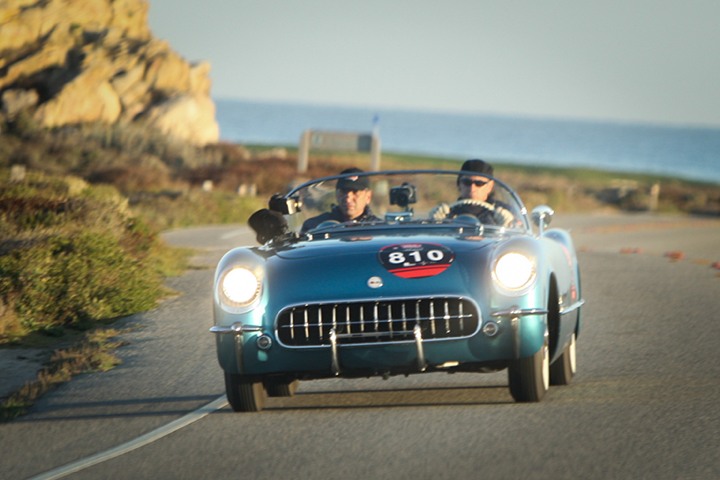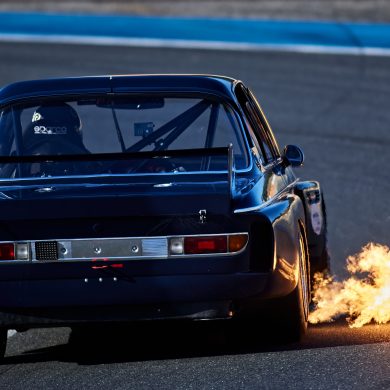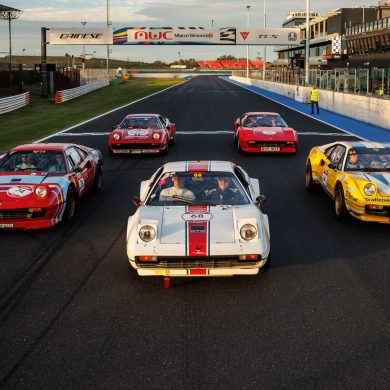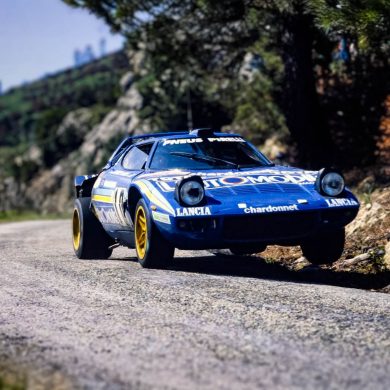The inaugural Mille Miglia North America Tribute was held October 25-29, 2011, starting and ending in Santa Barbara, California.
Event organizer Stratus Media Group, Inc., is sub-licensed to produce the Mille Miglia North America Tribute by the MAC Group, Meet Comunicazione and Sanremorally (ATI) – official licensees of the Mille Miglia trademarks and organizers of the famous automobile re-enactment in Italy. The ATI was the winner of the call for tenders relating to the ‘Historic Mille Miglia revival’ and to the license to use the ‘Mille Miglia’ brand called by the Automobile Club Brescia (ACB), organizer of the Mille Miglia since 1927 and proprietor of the trademarks.
California Mille Founder Martin Swig offered his thoughts on the Tribute, which prompted Sandro Binelli, MAC Group President and Secretary General of the Mille Miglia Organizing Committee, to offer the following questions and answers to describe his thoughts on the inaugural event.
Are you satisfied with the inaugural Mille Miglia North America Tribute?
Sandro Binelli: The first Mille Miglia North America Tribute was a success, as it achieved the goals we set for it, meaning to further expand the prestige of the Mille Miglia brand and spread its story, which began in Brescia in 1927 thanks to the Automobile Club Brescia, and has been revived for over 25 years with today’s revival event for classic cars. The Mille Miglia North America Tribute was organized following elevated standards of quality, consistent with the image and fame of the Mille Miglia.
We must not forget that International Mille Miglia Tributes are not and cannot be a replica of the Mille Miglia, an event which is – as I often stress – the only one of its kind anywhere in the world. Do not forget that neither the Tributes, nor any other event held outside of Italy with the Mille Miglia brand can be a clone of the Mille Miglia.
How did you face the fact that the number of cars entered was less than expected?
Sandro Binelli: We must not forget that the 2011 Mille Miglia North America Tribute was an event that had never been held before: as everyone knows, it takes time to build an event’s awareness and popularity and to affirm a start-up event. What is important is that the first Mille Miglia North America Tribute was a success and collectors loved it: the best outcome possible and a great achievement that gives the right grounds for an even better event in 2012, especially thinking of the number of participants.
I’d like to stress that as licensees of the Mille Miglia trademarks, we decided to make the North America Tribute in the form of a touring rally and to open it to all manufactured vehicles built between 1927 and 1957 meeting the elite standards set by the Mille Miglia as well as the ones with a particular historical value build between 1927-1957: priority was given to those that have driven the legendary Freccia Rossa (Red Arrow). As you know, participation in the Mille Miglia is limited to makes and models of cars manufactured between 1927 and 1957 that took part in at least one of the original Mille Miglia races. Having the Tribute not being a clone of the Mille Miglia, in agreement with the Automobile Club of Brescia, we decided deliberately not to restrict participation to Mille Miglia eligible models. It goes without saying that Mille Miglia eligible cars are always welcome to the Mille Miglia International Tributes: and the ones that ran the 2011 North America and future Tributes will be more than welcome to enter in the 2012 Mille Miglia.
On the other hand, as per the communiqué released in September by the Automobile Club of Brescia, “cars that, even when in possession of all the further requisites of participation required by the regulations, have participated in 2011 and/or 2012 events of any kind and/or typology that have abusively used the logos of the Mille Miglia (including the Red Arrow logo) and/or similar logos without them having been expressly authorised to do so by the Automobile Club of Brescia and/or the ATI” will not qualify.
An admission clause ruled by the Automobile Club of Brescia and applying to any event in the world using brands which are identical or similar to those legally owned by the Automobile Club of Brescia without the authorisation of the ACB,: it is important not to forget that we, MAC Group, along with Meet Comunicazione and Sanremorally (altogether, ATI) are the official licensees of the Mille Miglia trademarks and organizers of the regularity race in Italy. The ATI is the winner of the international call for tenders through private tendering relating to the ‘Historic Mille Miglia revival’ and to the license to use the ‘Mille Miglia’ brand called by the Automobile Club Brescia (ACB), organizer of the Mille Miglia since 1927 and world proprietor of the trademarks.
How do you respond to suggestions that the majority of entrants in the Mille Miglia North America Tribute did not meet the standards set by the Mille Miglia?
Sandro Binelli: While we are aware that the number of entrants can improve, we are satisfied with the cars entered in this first Mille Miglia North America Tribute. It is implied in the pattern of the event not to have exclusively Mille Miglia eligible cars: this year it was hard not to be overwhelmed by the two beautiful 1954 and 1957 Chevrolet Corvettes, which we were proud to have at the event even though the model did not run the historic Mille Miglia. As stated before, the international Tributes are not trying to and must not be clones of the Mille Miglia historic revival.
Organizers of the Mille Miglia North America Tribute were criticized for the choice of route which, according to Martin Swig, showed that Stratus Media had never driven an original Mille Miglia.
Sandro Binelli: Our partner Stratus Media Group, unlike Mr. Swig, carefully attended the most recent Mille Miglias: they had an observer’s approach so as to take in what makes it the world’s ‘greatest road race’ as Enzo Ferrari said. Part of the incredible charm of the Mille Miglia is the route, which crosses seven regions and passes through some of the most beautiful cities of Italy. Having done the whole route of the Mille Miglia North America Tribute I believe the choice for it was perfect. Just like the Mille Miglia, the route took entrants across the most diversified landscapes: mountains, seaboard and amazing countryside with vineyards and hills.
My opinion has been strongly supported by one of the participants, 2011 Mille Miglia winner Giordano Mozzi, who used the word “amazing” to describe the event. Another enthusiastic participant, Mr. Jeff Mamorsky, when extending his compliments for a job well done he said he “enjoyed the route selection, superb scenery and overall driving experience and am very much looking forward to next year’s event”. I believe that such remarks from experienced drivers speak for themselves.
Are you concerned about competition from existing USA events such as the California Mille and Colorado Grand?
Sandro Binelli: Having to face competition from existing events has never been a concern for us: an element of distinction itself is that the Mille Miglia International Tributes are organized following elevated standards of quality, consistent with the image and fame of the Mille Miglia. They are in the form of touring rallies and offer the knowledge of the history of the Mille Miglia. The tours are enriched by an itinerant exhibition telling the history of the Freccia Rossa (Red Arrow), of Brescia (the city in which the historical race originated) and of its territory: just like the 25 visuals telling the story of the Mille Miglia and its origins, on display during the Mille Miglia North America Tribute. The exhibition was promoted by and had the patronage of the Ministry of Agricultural, Food and Forestry Policies and the Italian Government Tourist Board (ENIT, Agenzia Nazionale del Turismo). Finally the Mille Miglia North America Tribute is the only event in the world to give the exclusive chance to participate in the 2012 Mille Miglia next May to five Mille Miglia eligible vehicles participating in it. The selection of the vehicles was made through a lottery and they received automatic acceptance to the historic Italian automotive event.
(See Martin Swig’s Thoughts on Mille Miglia North America Tribute 2011)
[Source: MAC Group]











For those judging from their armchairs, Alain de Cadenet offers some insights:
http://www.youtube.com/watch?v=wxHW75y2y70&feature=player_embedded
Thanks for posting the OTHER side of the coin, even if I don’t see eye-to-eye with most of their viewpoints. That’s what makes this a real magazine guys. Nicely done.
Yes Richard, but…
We all know and love Alain de Cadenet, but he’s hardly an unbiased opinion. He’s a hired gun, surely on the payroll of someone associated with the event. Great guy and always eloquent, but I take his opinion of this particular rally with a grain of salt.
It is my humble opinion that this war of words would end peacefully if MAC Group ended their childish ban of cars that participated in the California Mille and other events. Show some respect for the guys that paved the way, i.e. Martin Swig and others, and you will be rewarded accordingly. And if not, the event will continue to suffer from low quality entrants. Simple as that.
If you force people to choose their friends, they will choose their friends…that’s human nature guys!!
+1 +1 +1 +1 + 1
Could not agree more! It’s common sense.
You are right. I totally agree with you, Gary.
There is one issue within Sandro Binelli’s lengthy corporatespeak answers that I agree with. I have no doubt that the small number of entrants who actually showed up enjoyed themselves. However, I do not predict long term success for the event simply because Stratus Media Group is run by would-be financiers, not automotive enthusiasts.
The history of events, be they vintage races, vintage rallies or concours, that compromise entry standards in a blatent attempt to raise entry fee income, is not promising. Owners of 250 Testa Rossas do not race where Bondo Sprites that have been modified out of period compete. Steve Earle showed the other side of this coin when he always achieved the finest entry list in U.S. vintage racing during his 36 year stewardship of the Monterey Historic Automobile Races. He did it by not compromising, and by keeping out the junk.
Regarding the event in question, I do not believe too many owners of significant cars will want to share the road in the future with the likes of a 1941 Ford that lost its brakes in this year’s event.
From my own experience, I find owners of significant cars far more open minded and less pretentious than you mention.
BTW, the car in the tribute wasn’t a Bondo Sprite, it was a Westfield Lotus 11.
The Mille Miglia North America Tribute should be titled M.M.N.A.A. A for Avarice. Or M.M.N.A. Defecazione. Being licensed by the MAC Group which puts on the current version of the M.M. in Italy speaks of avarice. From 175 M.M. cars in the 1980s to 375 cars in the 2006 M.M. and now (2011) a pre-group of modern Ferraris, it is quantity of money over event quality. To pay Stratus $8000 to drive the public roads between Santa Barbara and Marin County with two trips through San Francisco traffic is insane. I feel very lucky to have experienced the M.M. in Italy in the late 1980s.
Without disagreeing with any of Steve Snyder’s other points, I’d like to mention that MAC took over the MM in 2008. In 2007, when the entries exceeded 300 cars, it was still being run by Constantino Franchi, so the escalation of entries can’t be blamed on MAC even if other degradations can. Even under Mr. Franchi, corporate involvement was intense. Mercedes and BMW, among others, entered fleets of historic vehicles trailed by support cars, and Mercedes even brought groups of customers to follow the event in modern supercars, which didn’t fit the vintage ambience. (I ran the event in 2007 with BMW.)
That said, putting on an event like the Mille Miglia Storica was undoubtedly a costly proposition, and the corporate involvement may well have been necessary to the event’s continuation. And in fairness to Mercedes and BMW, they do tend to enter excellent cars with the proper MM provenance, albeit in numbers that probably exceed what would be historically accurate. (I’m told that the ex-Stirling Moss car is a reproduction, which I can’t confirm though I know the BMWs are the real deal, at least in recent years.)
MAC’s contract to run the MM expires in 2012, so this particular saga only has one more year to run in any case. With luck, the MM will end up in the hands of respectful enthusiasts whose interests lie not in making money from the event but in providing an historically accurate rally in which the cars of the 1927-1957 race can be seen on the roads of Italy once again. Whoever has control of this event is charged with the preservation of something very special and rare, and I hope they appreciate what that means beyond the monetary value that can be assigned to this “commodity.”